University of Suffolk BA Business: Business Law and Ethics Report
VerifiedAdded on 2022/12/30
|12
|3861
|1
Report
AI Summary
This report delves into the realms of business law and ethics, offering an in-depth analysis of contractual relationships and their potential breaches, along with the corresponding remedies available. It presents a case study focusing on the intricacies of contract law, including essential elements for a valid contract, and the implications of counteroffers and promissory estoppel. Furthermore, the report investigates the ethical dimensions of business practices through an examination of the Bhopal gas tragedy, exploring the context of the disaster, including the background of Union Carbide, the warning signs preceding the event, and the causes of the gas leak. The report highlights the critical importance of adhering to ethical principles and legal frameworks in the business sector to prevent such catastrophic events. The analysis includes relevant case studies, such as Balfour v. Balfour, Hyde v. Wrench, and D&C Builders v. Rees to support the arguments.
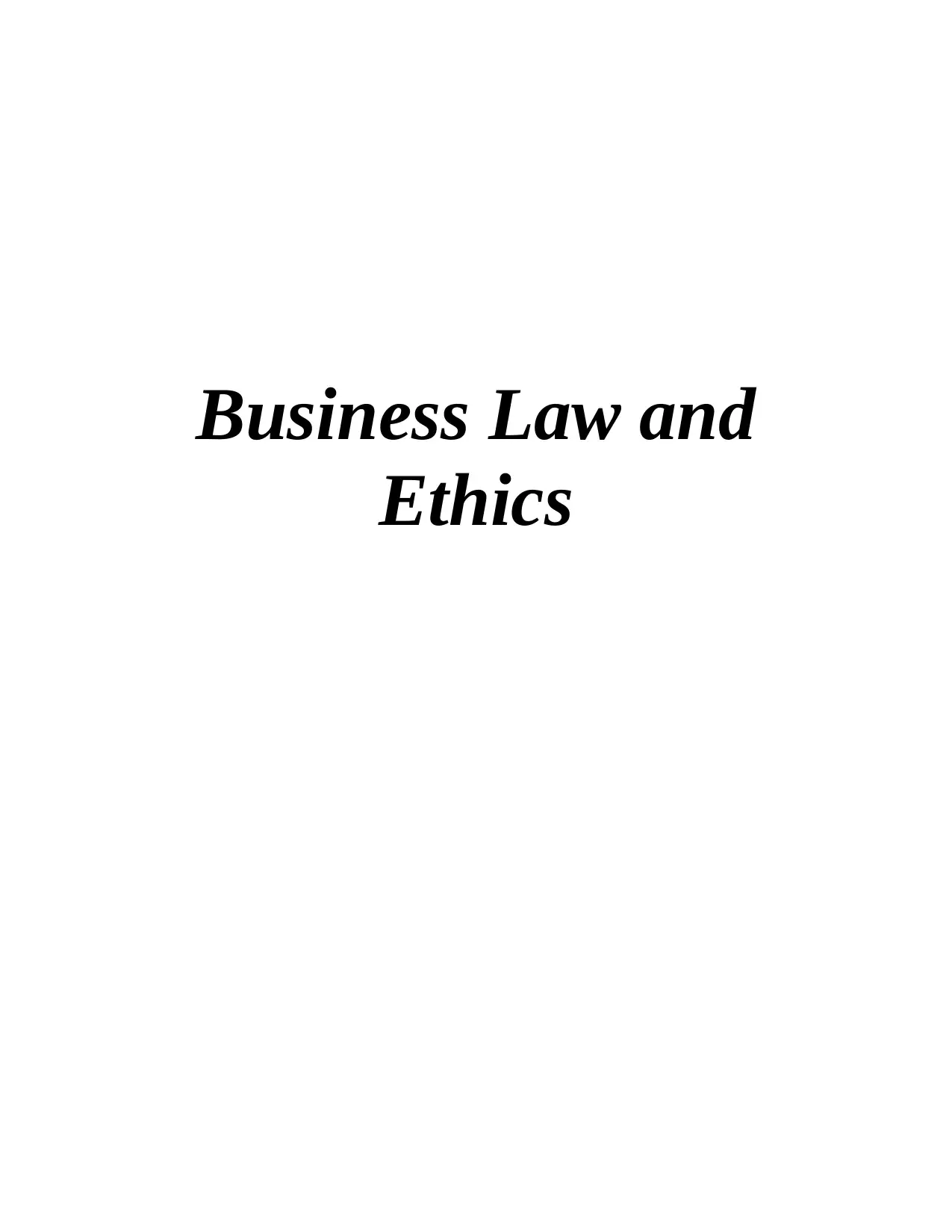
Business Law and
Ethics
Ethics
Paraphrase This Document
Need a fresh take? Get an instant paraphrase of this document with our AI Paraphraser
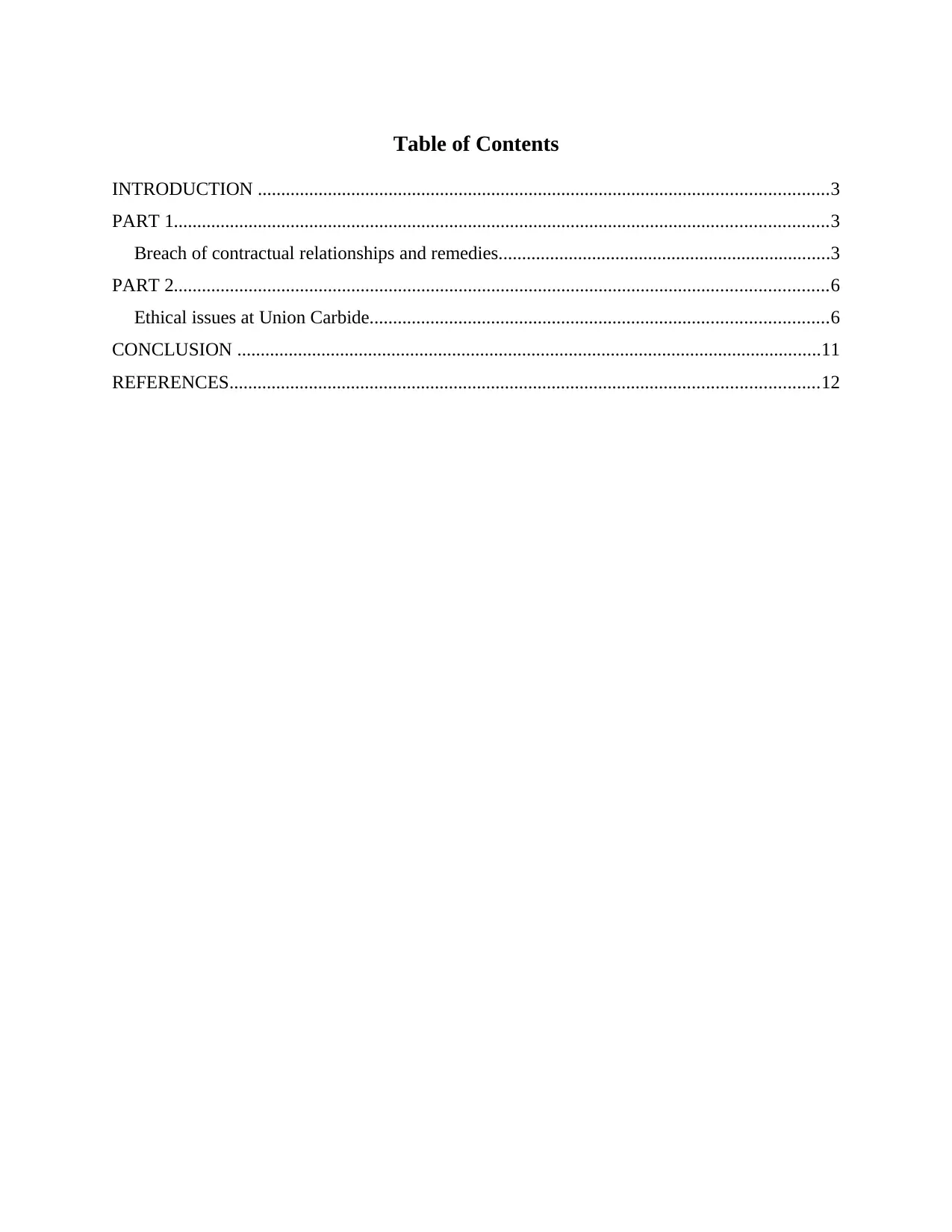
Table of Contents
INTRODUCTION ..........................................................................................................................3
PART 1............................................................................................................................................3
Breach of contractual relationships and remedies.......................................................................3
PART 2............................................................................................................................................6
Ethical issues at Union Carbide..................................................................................................6
CONCLUSION .............................................................................................................................11
REFERENCES..............................................................................................................................12
INTRODUCTION ..........................................................................................................................3
PART 1............................................................................................................................................3
Breach of contractual relationships and remedies.......................................................................3
PART 2............................................................................................................................................6
Ethical issues at Union Carbide..................................................................................................6
CONCLUSION .............................................................................................................................11
REFERENCES..............................................................................................................................12
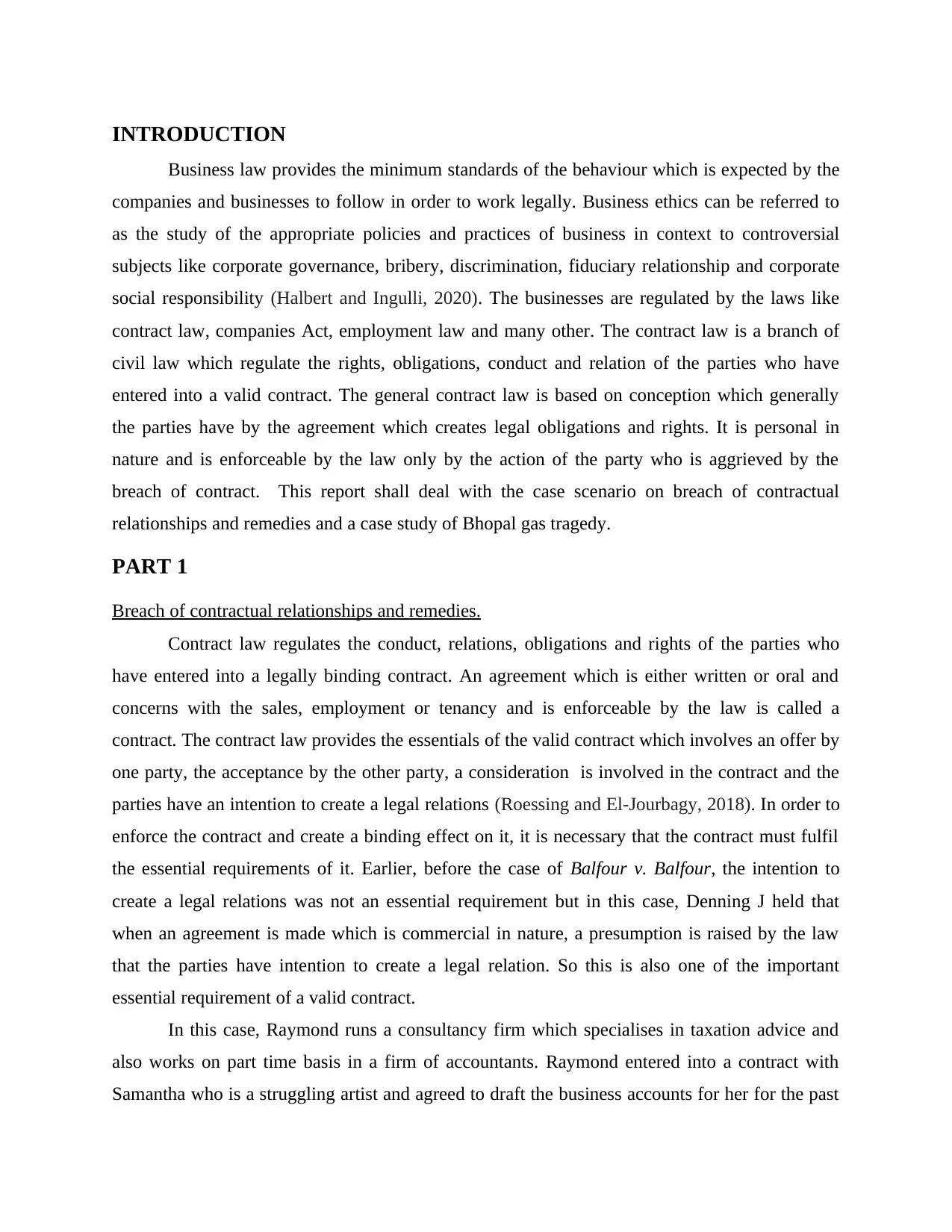
INTRODUCTION
Business law provides the minimum standards of the behaviour which is expected by the
companies and businesses to follow in order to work legally. Business ethics can be referred to
as the study of the appropriate policies and practices of business in context to controversial
subjects like corporate governance, bribery, discrimination, fiduciary relationship and corporate
social responsibility (Halbert and Ingulli, 2020). The businesses are regulated by the laws like
contract law, companies Act, employment law and many other. The contract law is a branch of
civil law which regulate the rights, obligations, conduct and relation of the parties who have
entered into a valid contract. The general contract law is based on conception which generally
the parties have by the agreement which creates legal obligations and rights. It is personal in
nature and is enforceable by the law only by the action of the party who is aggrieved by the
breach of contract. This report shall deal with the case scenario on breach of contractual
relationships and remedies and a case study of Bhopal gas tragedy.
PART 1
Breach of contractual relationships and remedies.
Contract law regulates the conduct, relations, obligations and rights of the parties who
have entered into a legally binding contract. An agreement which is either written or oral and
concerns with the sales, employment or tenancy and is enforceable by the law is called a
contract. The contract law provides the essentials of the valid contract which involves an offer by
one party, the acceptance by the other party, a consideration is involved in the contract and the
parties have an intention to create a legal relations (Roessing and El-Jourbagy, 2018). In order to
enforce the contract and create a binding effect on it, it is necessary that the contract must fulfil
the essential requirements of it. Earlier, before the case of Balfour v. Balfour, the intention to
create a legal relations was not an essential requirement but in this case, Denning J held that
when an agreement is made which is commercial in nature, a presumption is raised by the law
that the parties have intention to create a legal relation. So this is also one of the important
essential requirement of a valid contract.
In this case, Raymond runs a consultancy firm which specialises in taxation advice and
also works on part time basis in a firm of accountants. Raymond entered into a contract with
Samantha who is a struggling artist and agreed to draft the business accounts for her for the past
Business law provides the minimum standards of the behaviour which is expected by the
companies and businesses to follow in order to work legally. Business ethics can be referred to
as the study of the appropriate policies and practices of business in context to controversial
subjects like corporate governance, bribery, discrimination, fiduciary relationship and corporate
social responsibility (Halbert and Ingulli, 2020). The businesses are regulated by the laws like
contract law, companies Act, employment law and many other. The contract law is a branch of
civil law which regulate the rights, obligations, conduct and relation of the parties who have
entered into a valid contract. The general contract law is based on conception which generally
the parties have by the agreement which creates legal obligations and rights. It is personal in
nature and is enforceable by the law only by the action of the party who is aggrieved by the
breach of contract. This report shall deal with the case scenario on breach of contractual
relationships and remedies and a case study of Bhopal gas tragedy.
PART 1
Breach of contractual relationships and remedies.
Contract law regulates the conduct, relations, obligations and rights of the parties who
have entered into a legally binding contract. An agreement which is either written or oral and
concerns with the sales, employment or tenancy and is enforceable by the law is called a
contract. The contract law provides the essentials of the valid contract which involves an offer by
one party, the acceptance by the other party, a consideration is involved in the contract and the
parties have an intention to create a legal relations (Roessing and El-Jourbagy, 2018). In order to
enforce the contract and create a binding effect on it, it is necessary that the contract must fulfil
the essential requirements of it. Earlier, before the case of Balfour v. Balfour, the intention to
create a legal relations was not an essential requirement but in this case, Denning J held that
when an agreement is made which is commercial in nature, a presumption is raised by the law
that the parties have intention to create a legal relation. So this is also one of the important
essential requirement of a valid contract.
In this case, Raymond runs a consultancy firm which specialises in taxation advice and
also works on part time basis in a firm of accountants. Raymond entered into a contract with
Samantha who is a struggling artist and agreed to draft the business accounts for her for the past
⊘ This is a preview!⊘
Do you want full access?
Subscribe today to unlock all pages.

Trusted by 1+ million students worldwide
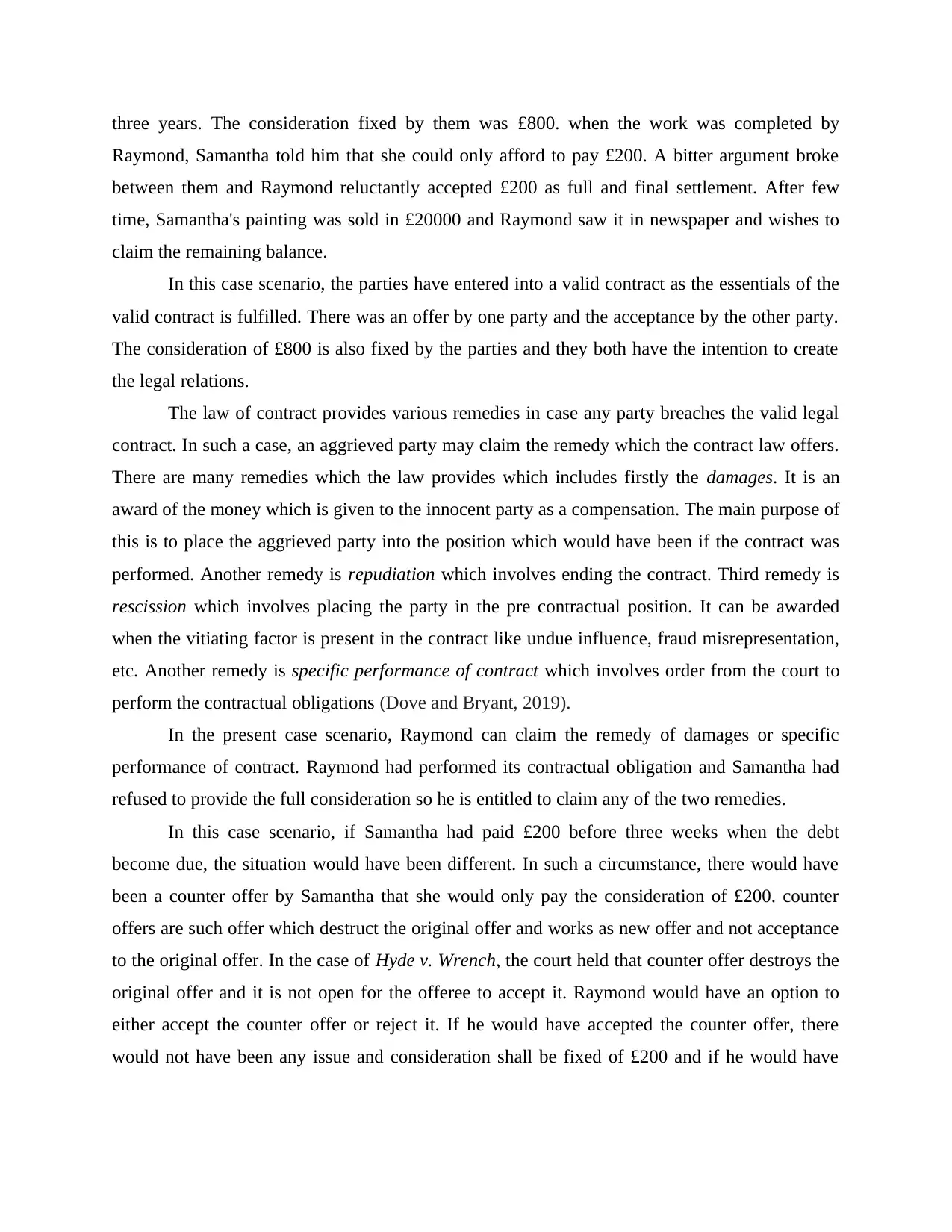
three years. The consideration fixed by them was £800. when the work was completed by
Raymond, Samantha told him that she could only afford to pay £200. A bitter argument broke
between them and Raymond reluctantly accepted £200 as full and final settlement. After few
time, Samantha's painting was sold in £20000 and Raymond saw it in newspaper and wishes to
claim the remaining balance.
In this case scenario, the parties have entered into a valid contract as the essentials of the
valid contract is fulfilled. There was an offer by one party and the acceptance by the other party.
The consideration of £800 is also fixed by the parties and they both have the intention to create
the legal relations.
The law of contract provides various remedies in case any party breaches the valid legal
contract. In such a case, an aggrieved party may claim the remedy which the contract law offers.
There are many remedies which the law provides which includes firstly the damages. It is an
award of the money which is given to the innocent party as a compensation. The main purpose of
this is to place the aggrieved party into the position which would have been if the contract was
performed. Another remedy is repudiation which involves ending the contract. Third remedy is
rescission which involves placing the party in the pre contractual position. It can be awarded
when the vitiating factor is present in the contract like undue influence, fraud misrepresentation,
etc. Another remedy is specific performance of contract which involves order from the court to
perform the contractual obligations (Dove and Bryant, 2019).
In the present case scenario, Raymond can claim the remedy of damages or specific
performance of contract. Raymond had performed its contractual obligation and Samantha had
refused to provide the full consideration so he is entitled to claim any of the two remedies.
In this case scenario, if Samantha had paid £200 before three weeks when the debt
become due, the situation would have been different. In such a circumstance, there would have
been a counter offer by Samantha that she would only pay the consideration of £200. counter
offers are such offer which destruct the original offer and works as new offer and not acceptance
to the original offer. In the case of Hyde v. Wrench, the court held that counter offer destroys the
original offer and it is not open for the offeree to accept it. Raymond would have an option to
either accept the counter offer or reject it. If he would have accepted the counter offer, there
would not have been any issue and consideration shall be fixed of £200 and if he would have
Raymond, Samantha told him that she could only afford to pay £200. A bitter argument broke
between them and Raymond reluctantly accepted £200 as full and final settlement. After few
time, Samantha's painting was sold in £20000 and Raymond saw it in newspaper and wishes to
claim the remaining balance.
In this case scenario, the parties have entered into a valid contract as the essentials of the
valid contract is fulfilled. There was an offer by one party and the acceptance by the other party.
The consideration of £800 is also fixed by the parties and they both have the intention to create
the legal relations.
The law of contract provides various remedies in case any party breaches the valid legal
contract. In such a case, an aggrieved party may claim the remedy which the contract law offers.
There are many remedies which the law provides which includes firstly the damages. It is an
award of the money which is given to the innocent party as a compensation. The main purpose of
this is to place the aggrieved party into the position which would have been if the contract was
performed. Another remedy is repudiation which involves ending the contract. Third remedy is
rescission which involves placing the party in the pre contractual position. It can be awarded
when the vitiating factor is present in the contract like undue influence, fraud misrepresentation,
etc. Another remedy is specific performance of contract which involves order from the court to
perform the contractual obligations (Dove and Bryant, 2019).
In the present case scenario, Raymond can claim the remedy of damages or specific
performance of contract. Raymond had performed its contractual obligation and Samantha had
refused to provide the full consideration so he is entitled to claim any of the two remedies.
In this case scenario, if Samantha had paid £200 before three weeks when the debt
become due, the situation would have been different. In such a circumstance, there would have
been a counter offer by Samantha that she would only pay the consideration of £200. counter
offers are such offer which destruct the original offer and works as new offer and not acceptance
to the original offer. In the case of Hyde v. Wrench, the court held that counter offer destroys the
original offer and it is not open for the offeree to accept it. Raymond would have an option to
either accept the counter offer or reject it. If he would have accepted the counter offer, there
would not have been any issue and consideration shall be fixed of £200 and if he would have
Paraphrase This Document
Need a fresh take? Get an instant paraphrase of this document with our AI Paraphraser
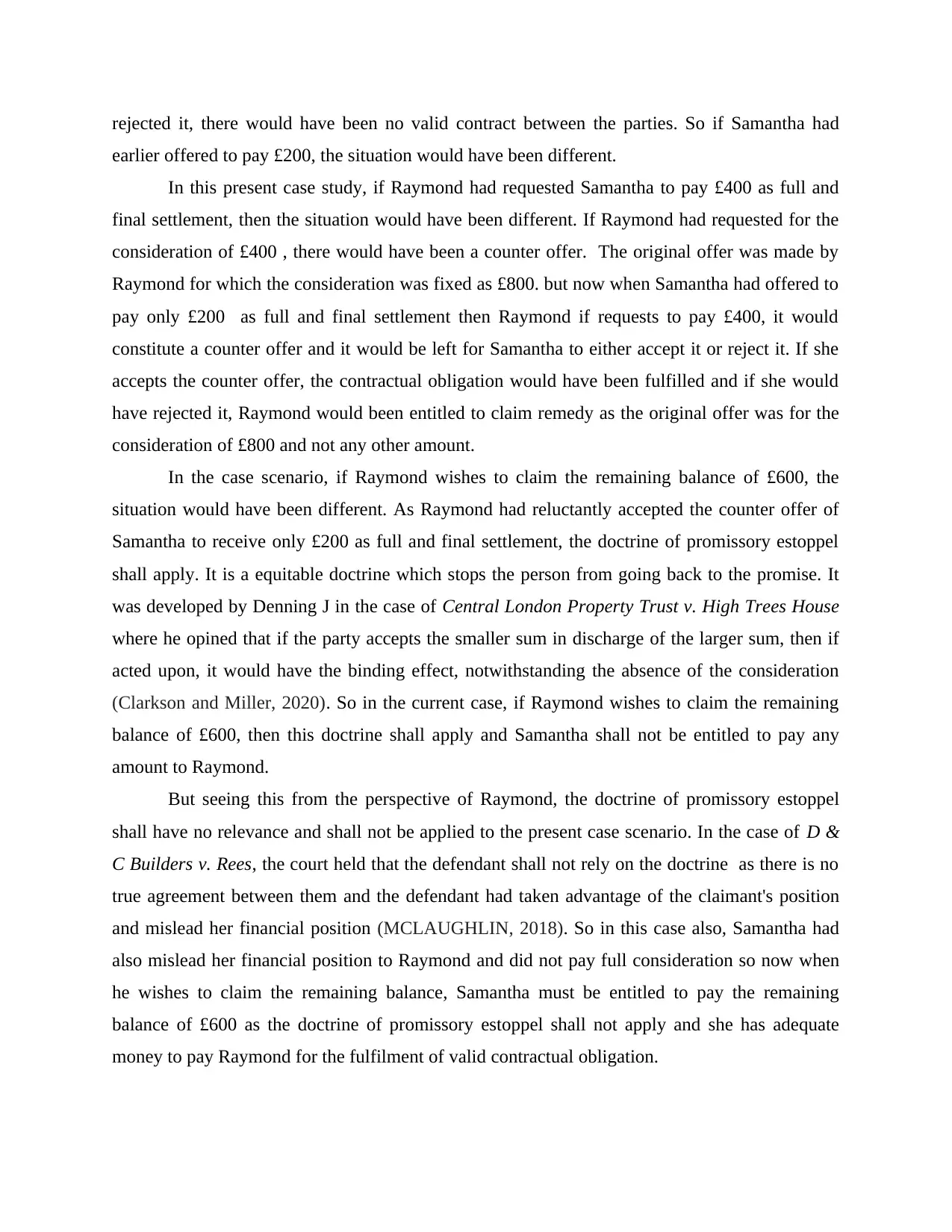
rejected it, there would have been no valid contract between the parties. So if Samantha had
earlier offered to pay £200, the situation would have been different.
In this present case study, if Raymond had requested Samantha to pay £400 as full and
final settlement, then the situation would have been different. If Raymond had requested for the
consideration of £400 , there would have been a counter offer. The original offer was made by
Raymond for which the consideration was fixed as £800. but now when Samantha had offered to
pay only £200 as full and final settlement then Raymond if requests to pay £400, it would
constitute a counter offer and it would be left for Samantha to either accept it or reject it. If she
accepts the counter offer, the contractual obligation would have been fulfilled and if she would
have rejected it, Raymond would been entitled to claim remedy as the original offer was for the
consideration of £800 and not any other amount.
In the case scenario, if Raymond wishes to claim the remaining balance of £600, the
situation would have been different. As Raymond had reluctantly accepted the counter offer of
Samantha to receive only £200 as full and final settlement, the doctrine of promissory estoppel
shall apply. It is a equitable doctrine which stops the person from going back to the promise. It
was developed by Denning J in the case of Central London Property Trust v. High Trees House
where he opined that if the party accepts the smaller sum in discharge of the larger sum, then if
acted upon, it would have the binding effect, notwithstanding the absence of the consideration
(Clarkson and Miller, 2020). So in the current case, if Raymond wishes to claim the remaining
balance of £600, then this doctrine shall apply and Samantha shall not be entitled to pay any
amount to Raymond.
But seeing this from the perspective of Raymond, the doctrine of promissory estoppel
shall have no relevance and shall not be applied to the present case scenario. In the case of D &
C Builders v. Rees, the court held that the defendant shall not rely on the doctrine as there is no
true agreement between them and the defendant had taken advantage of the claimant's position
and mislead her financial position (MCLAUGHLIN, 2018). So in this case also, Samantha had
also mislead her financial position to Raymond and did not pay full consideration so now when
he wishes to claim the remaining balance, Samantha must be entitled to pay the remaining
balance of £600 as the doctrine of promissory estoppel shall not apply and she has adequate
money to pay Raymond for the fulfilment of valid contractual obligation.
earlier offered to pay £200, the situation would have been different.
In this present case study, if Raymond had requested Samantha to pay £400 as full and
final settlement, then the situation would have been different. If Raymond had requested for the
consideration of £400 , there would have been a counter offer. The original offer was made by
Raymond for which the consideration was fixed as £800. but now when Samantha had offered to
pay only £200 as full and final settlement then Raymond if requests to pay £400, it would
constitute a counter offer and it would be left for Samantha to either accept it or reject it. If she
accepts the counter offer, the contractual obligation would have been fulfilled and if she would
have rejected it, Raymond would been entitled to claim remedy as the original offer was for the
consideration of £800 and not any other amount.
In the case scenario, if Raymond wishes to claim the remaining balance of £600, the
situation would have been different. As Raymond had reluctantly accepted the counter offer of
Samantha to receive only £200 as full and final settlement, the doctrine of promissory estoppel
shall apply. It is a equitable doctrine which stops the person from going back to the promise. It
was developed by Denning J in the case of Central London Property Trust v. High Trees House
where he opined that if the party accepts the smaller sum in discharge of the larger sum, then if
acted upon, it would have the binding effect, notwithstanding the absence of the consideration
(Clarkson and Miller, 2020). So in the current case, if Raymond wishes to claim the remaining
balance of £600, then this doctrine shall apply and Samantha shall not be entitled to pay any
amount to Raymond.
But seeing this from the perspective of Raymond, the doctrine of promissory estoppel
shall have no relevance and shall not be applied to the present case scenario. In the case of D &
C Builders v. Rees, the court held that the defendant shall not rely on the doctrine as there is no
true agreement between them and the defendant had taken advantage of the claimant's position
and mislead her financial position (MCLAUGHLIN, 2018). So in this case also, Samantha had
also mislead her financial position to Raymond and did not pay full consideration so now when
he wishes to claim the remaining balance, Samantha must be entitled to pay the remaining
balance of £600 as the doctrine of promissory estoppel shall not apply and she has adequate
money to pay Raymond for the fulfilment of valid contractual obligation.
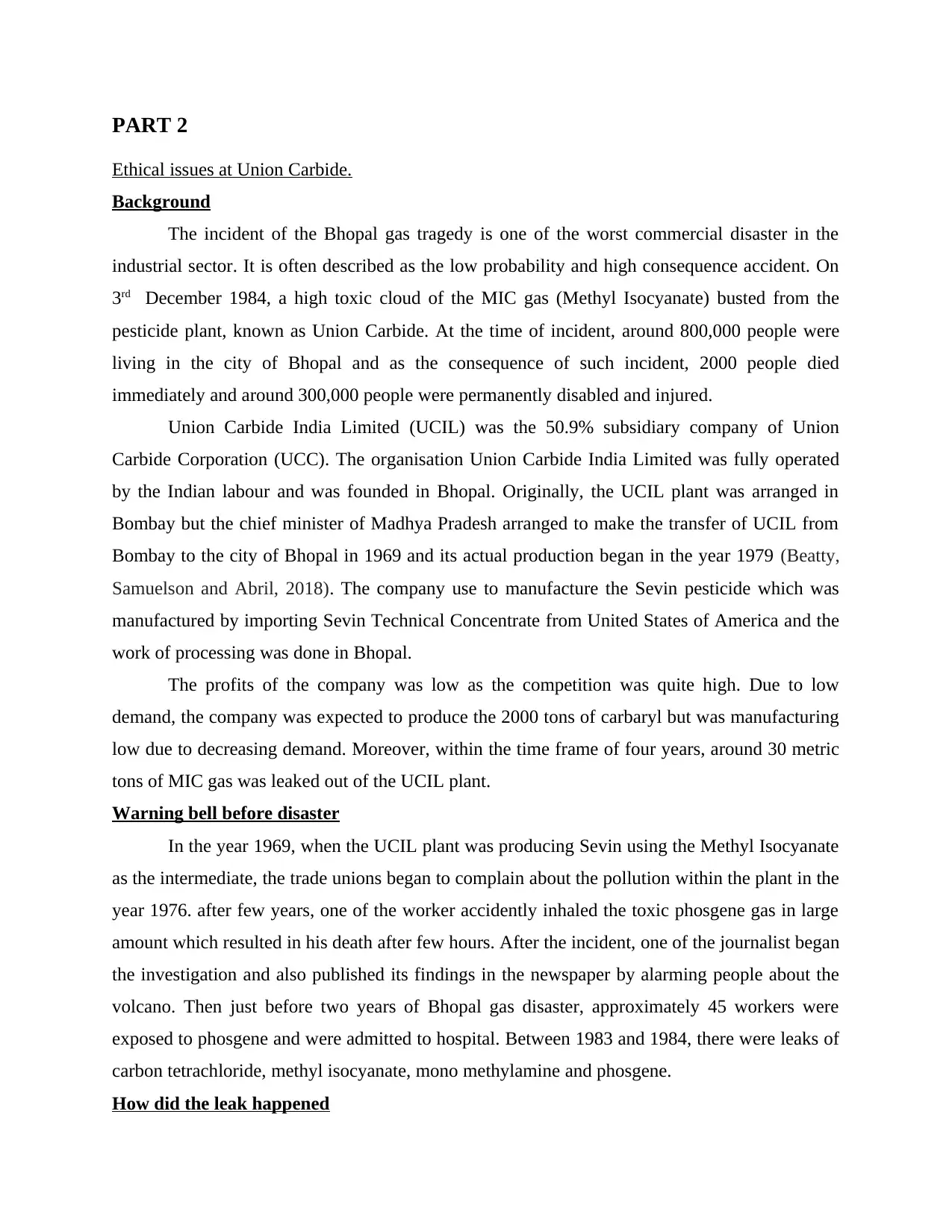
PART 2
Ethical issues at Union Carbide.
Background
The incident of the Bhopal gas tragedy is one of the worst commercial disaster in the
industrial sector. It is often described as the low probability and high consequence accident. On
3rd December 1984, a high toxic cloud of the MIC gas (Methyl Isocyanate) busted from the
pesticide plant, known as Union Carbide. At the time of incident, around 800,000 people were
living in the city of Bhopal and as the consequence of such incident, 2000 people died
immediately and around 300,000 people were permanently disabled and injured.
Union Carbide India Limited (UCIL) was the 50.9% subsidiary company of Union
Carbide Corporation (UCC). The organisation Union Carbide India Limited was fully operated
by the Indian labour and was founded in Bhopal. Originally, the UCIL plant was arranged in
Bombay but the chief minister of Madhya Pradesh arranged to make the transfer of UCIL from
Bombay to the city of Bhopal in 1969 and its actual production began in the year 1979 (Beatty,
Samuelson and Abril, 2018). The company use to manufacture the Sevin pesticide which was
manufactured by importing Sevin Technical Concentrate from United States of America and the
work of processing was done in Bhopal.
The profits of the company was low as the competition was quite high. Due to low
demand, the company was expected to produce the 2000 tons of carbaryl but was manufacturing
low due to decreasing demand. Moreover, within the time frame of four years, around 30 metric
tons of MIC gas was leaked out of the UCIL plant.
Warning bell before disaster
In the year 1969, when the UCIL plant was producing Sevin using the Methyl Isocyanate
as the intermediate, the trade unions began to complain about the pollution within the plant in the
year 1976. after few years, one of the worker accidently inhaled the toxic phosgene gas in large
amount which resulted in his death after few hours. After the incident, one of the journalist began
the investigation and also published its findings in the newspaper by alarming people about the
volcano. Then just before two years of Bhopal gas disaster, approximately 45 workers were
exposed to phosgene and were admitted to hospital. Between 1983 and 1984, there were leaks of
carbon tetrachloride, methyl isocyanate, mono methylamine and phosgene.
How did the leak happened
Ethical issues at Union Carbide.
Background
The incident of the Bhopal gas tragedy is one of the worst commercial disaster in the
industrial sector. It is often described as the low probability and high consequence accident. On
3rd December 1984, a high toxic cloud of the MIC gas (Methyl Isocyanate) busted from the
pesticide plant, known as Union Carbide. At the time of incident, around 800,000 people were
living in the city of Bhopal and as the consequence of such incident, 2000 people died
immediately and around 300,000 people were permanently disabled and injured.
Union Carbide India Limited (UCIL) was the 50.9% subsidiary company of Union
Carbide Corporation (UCC). The organisation Union Carbide India Limited was fully operated
by the Indian labour and was founded in Bhopal. Originally, the UCIL plant was arranged in
Bombay but the chief minister of Madhya Pradesh arranged to make the transfer of UCIL from
Bombay to the city of Bhopal in 1969 and its actual production began in the year 1979 (Beatty,
Samuelson and Abril, 2018). The company use to manufacture the Sevin pesticide which was
manufactured by importing Sevin Technical Concentrate from United States of America and the
work of processing was done in Bhopal.
The profits of the company was low as the competition was quite high. Due to low
demand, the company was expected to produce the 2000 tons of carbaryl but was manufacturing
low due to decreasing demand. Moreover, within the time frame of four years, around 30 metric
tons of MIC gas was leaked out of the UCIL plant.
Warning bell before disaster
In the year 1969, when the UCIL plant was producing Sevin using the Methyl Isocyanate
as the intermediate, the trade unions began to complain about the pollution within the plant in the
year 1976. after few years, one of the worker accidently inhaled the toxic phosgene gas in large
amount which resulted in his death after few hours. After the incident, one of the journalist began
the investigation and also published its findings in the newspaper by alarming people about the
volcano. Then just before two years of Bhopal gas disaster, approximately 45 workers were
exposed to phosgene and were admitted to hospital. Between 1983 and 1984, there were leaks of
carbon tetrachloride, methyl isocyanate, mono methylamine and phosgene.
How did the leak happened
⊘ This is a preview!⊘
Do you want full access?
Subscribe today to unlock all pages.

Trusted by 1+ million students worldwide
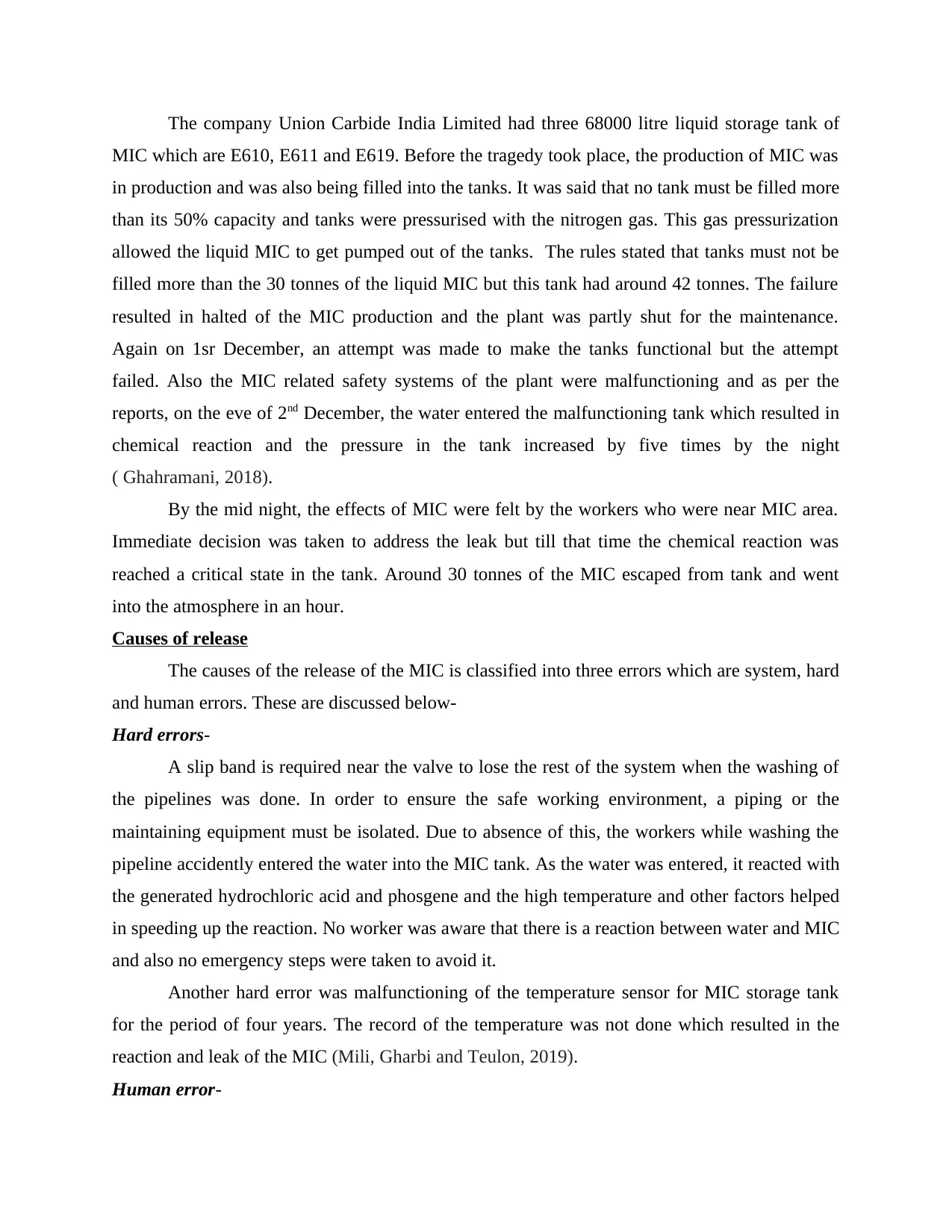
The company Union Carbide India Limited had three 68000 litre liquid storage tank of
MIC which are E610, E611 and E619. Before the tragedy took place, the production of MIC was
in production and was also being filled into the tanks. It was said that no tank must be filled more
than its 50% capacity and tanks were pressurised with the nitrogen gas. This gas pressurization
allowed the liquid MIC to get pumped out of the tanks. The rules stated that tanks must not be
filled more than the 30 tonnes of the liquid MIC but this tank had around 42 tonnes. The failure
resulted in halted of the MIC production and the plant was partly shut for the maintenance.
Again on 1sr December, an attempt was made to make the tanks functional but the attempt
failed. Also the MIC related safety systems of the plant were malfunctioning and as per the
reports, on the eve of 2nd December, the water entered the malfunctioning tank which resulted in
chemical reaction and the pressure in the tank increased by five times by the night
( Ghahramani, 2018).
By the mid night, the effects of MIC were felt by the workers who were near MIC area.
Immediate decision was taken to address the leak but till that time the chemical reaction was
reached a critical state in the tank. Around 30 tonnes of the MIC escaped from tank and went
into the atmosphere in an hour.
Causes of release
The causes of the release of the MIC is classified into three errors which are system, hard
and human errors. These are discussed below-
Hard errors-
A slip band is required near the valve to lose the rest of the system when the washing of
the pipelines was done. In order to ensure the safe working environment, a piping or the
maintaining equipment must be isolated. Due to absence of this, the workers while washing the
pipeline accidently entered the water into the MIC tank. As the water was entered, it reacted with
the generated hydrochloric acid and phosgene and the high temperature and other factors helped
in speeding up the reaction. No worker was aware that there is a reaction between water and MIC
and also no emergency steps were taken to avoid it.
Another hard error was malfunctioning of the temperature sensor for MIC storage tank
for the period of four years. The record of the temperature was not done which resulted in the
reaction and leak of the MIC (Mili, Gharbi and Teulon, 2019).
Human error-
MIC which are E610, E611 and E619. Before the tragedy took place, the production of MIC was
in production and was also being filled into the tanks. It was said that no tank must be filled more
than its 50% capacity and tanks were pressurised with the nitrogen gas. This gas pressurization
allowed the liquid MIC to get pumped out of the tanks. The rules stated that tanks must not be
filled more than the 30 tonnes of the liquid MIC but this tank had around 42 tonnes. The failure
resulted in halted of the MIC production and the plant was partly shut for the maintenance.
Again on 1sr December, an attempt was made to make the tanks functional but the attempt
failed. Also the MIC related safety systems of the plant were malfunctioning and as per the
reports, on the eve of 2nd December, the water entered the malfunctioning tank which resulted in
chemical reaction and the pressure in the tank increased by five times by the night
( Ghahramani, 2018).
By the mid night, the effects of MIC were felt by the workers who were near MIC area.
Immediate decision was taken to address the leak but till that time the chemical reaction was
reached a critical state in the tank. Around 30 tonnes of the MIC escaped from tank and went
into the atmosphere in an hour.
Causes of release
The causes of the release of the MIC is classified into three errors which are system, hard
and human errors. These are discussed below-
Hard errors-
A slip band is required near the valve to lose the rest of the system when the washing of
the pipelines was done. In order to ensure the safe working environment, a piping or the
maintaining equipment must be isolated. Due to absence of this, the workers while washing the
pipeline accidently entered the water into the MIC tank. As the water was entered, it reacted with
the generated hydrochloric acid and phosgene and the high temperature and other factors helped
in speeding up the reaction. No worker was aware that there is a reaction between water and MIC
and also no emergency steps were taken to avoid it.
Another hard error was malfunctioning of the temperature sensor for MIC storage tank
for the period of four years. The record of the temperature was not done which resulted in the
reaction and leak of the MIC (Mili, Gharbi and Teulon, 2019).
Human error-
Paraphrase This Document
Need a fresh take? Get an instant paraphrase of this document with our AI Paraphraser
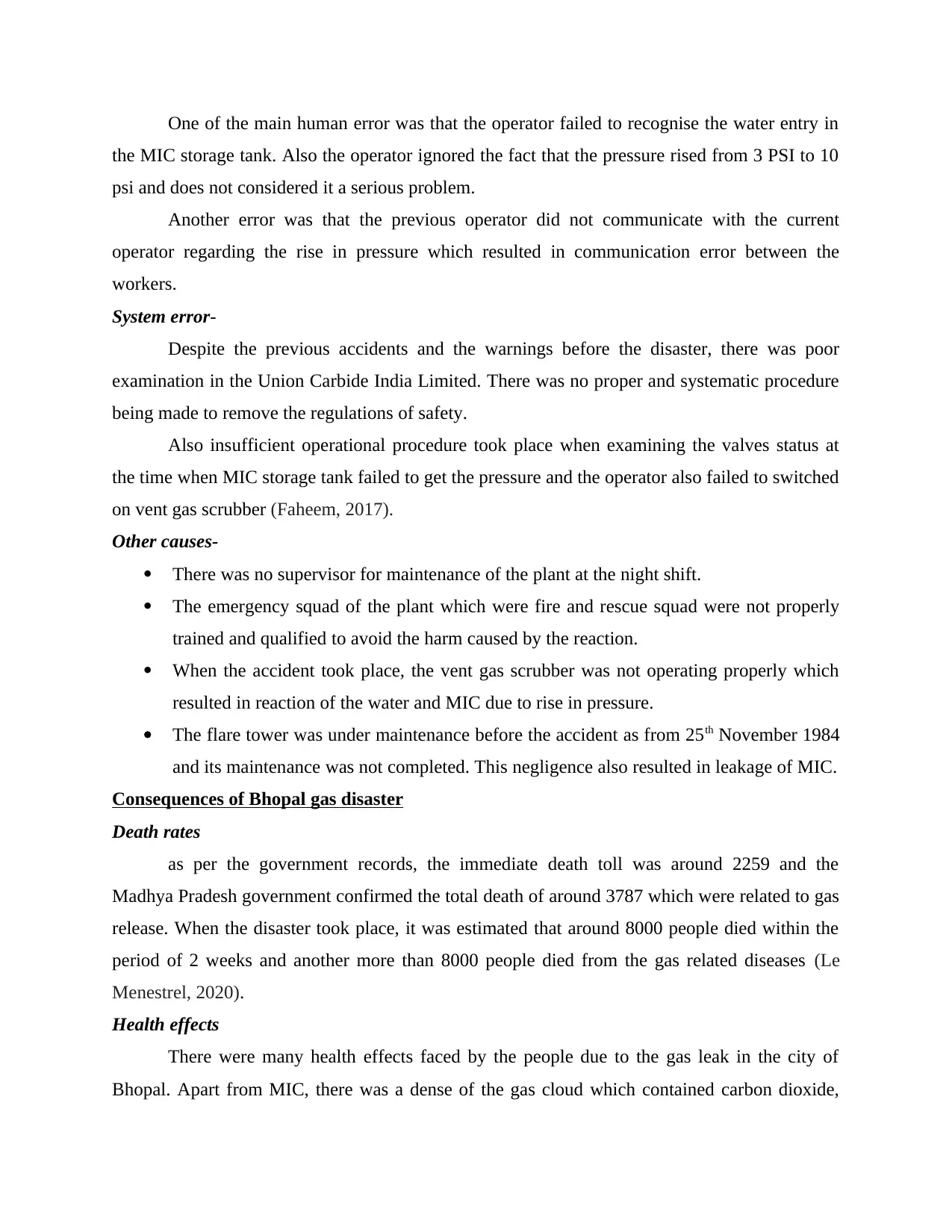
One of the main human error was that the operator failed to recognise the water entry in
the MIC storage tank. Also the operator ignored the fact that the pressure rised from 3 PSI to 10
psi and does not considered it a serious problem.
Another error was that the previous operator did not communicate with the current
operator regarding the rise in pressure which resulted in communication error between the
workers.
System error-
Despite the previous accidents and the warnings before the disaster, there was poor
examination in the Union Carbide India Limited. There was no proper and systematic procedure
being made to remove the regulations of safety.
Also insufficient operational procedure took place when examining the valves status at
the time when MIC storage tank failed to get the pressure and the operator also failed to switched
on vent gas scrubber (Faheem, 2017).
Other causes-
There was no supervisor for maintenance of the plant at the night shift.
The emergency squad of the plant which were fire and rescue squad were not properly
trained and qualified to avoid the harm caused by the reaction.
When the accident took place, the vent gas scrubber was not operating properly which
resulted in reaction of the water and MIC due to rise in pressure.
The flare tower was under maintenance before the accident as from 25th November 1984
and its maintenance was not completed. This negligence also resulted in leakage of MIC.
Consequences of Bhopal gas disaster
Death rates
as per the government records, the immediate death toll was around 2259 and the
Madhya Pradesh government confirmed the total death of around 3787 which were related to gas
release. When the disaster took place, it was estimated that around 8000 people died within the
period of 2 weeks and another more than 8000 people died from the gas related diseases (Le
Menestrel, 2020).
Health effects
There were many health effects faced by the people due to the gas leak in the city of
Bhopal. Apart from MIC, there was a dense of the gas cloud which contained carbon dioxide,
the MIC storage tank. Also the operator ignored the fact that the pressure rised from 3 PSI to 10
psi and does not considered it a serious problem.
Another error was that the previous operator did not communicate with the current
operator regarding the rise in pressure which resulted in communication error between the
workers.
System error-
Despite the previous accidents and the warnings before the disaster, there was poor
examination in the Union Carbide India Limited. There was no proper and systematic procedure
being made to remove the regulations of safety.
Also insufficient operational procedure took place when examining the valves status at
the time when MIC storage tank failed to get the pressure and the operator also failed to switched
on vent gas scrubber (Faheem, 2017).
Other causes-
There was no supervisor for maintenance of the plant at the night shift.
The emergency squad of the plant which were fire and rescue squad were not properly
trained and qualified to avoid the harm caused by the reaction.
When the accident took place, the vent gas scrubber was not operating properly which
resulted in reaction of the water and MIC due to rise in pressure.
The flare tower was under maintenance before the accident as from 25th November 1984
and its maintenance was not completed. This negligence also resulted in leakage of MIC.
Consequences of Bhopal gas disaster
Death rates
as per the government records, the immediate death toll was around 2259 and the
Madhya Pradesh government confirmed the total death of around 3787 which were related to gas
release. When the disaster took place, it was estimated that around 8000 people died within the
period of 2 weeks and another more than 8000 people died from the gas related diseases (Le
Menestrel, 2020).
Health effects
There were many health effects faced by the people due to the gas leak in the city of
Bhopal. Apart from MIC, there was a dense of the gas cloud which contained carbon dioxide,
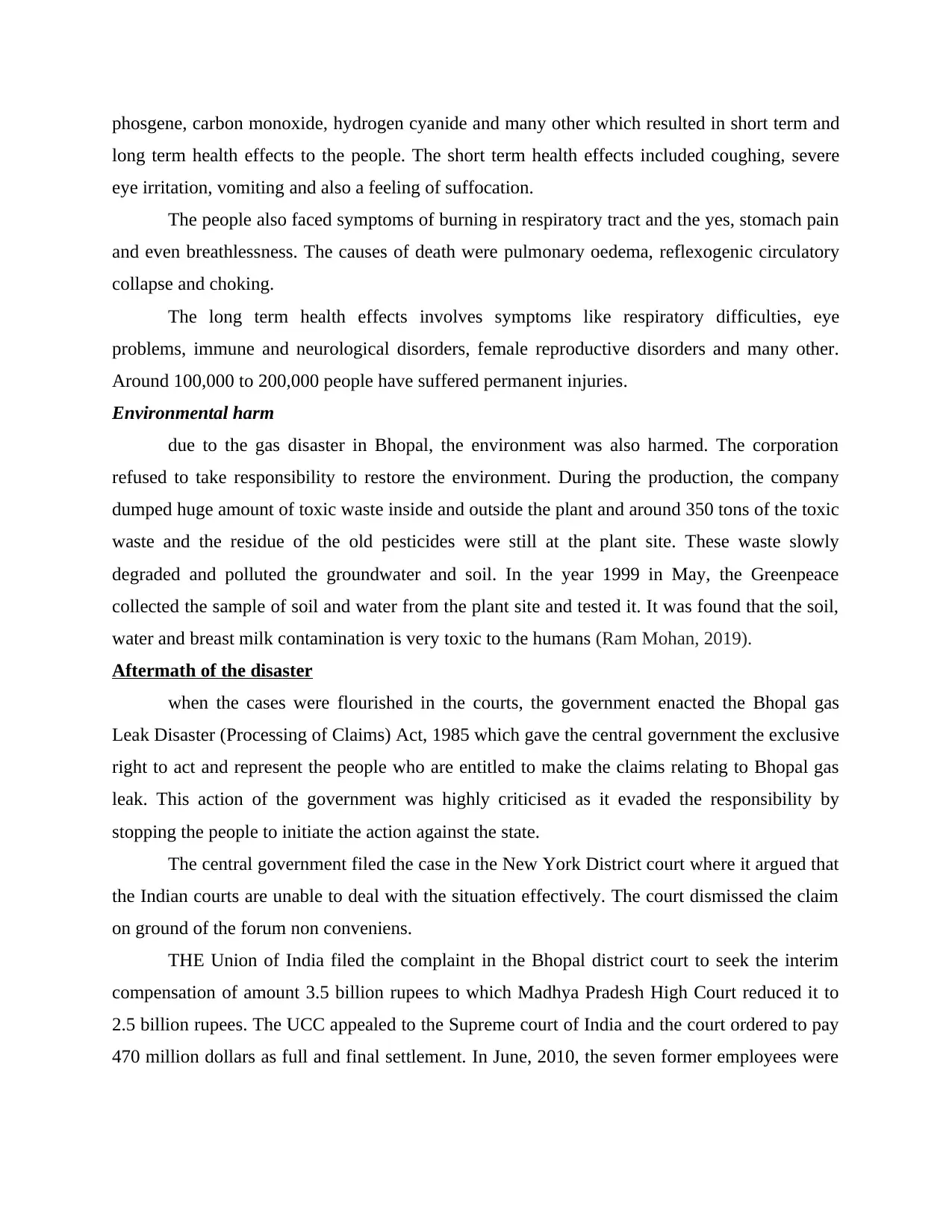
phosgene, carbon monoxide, hydrogen cyanide and many other which resulted in short term and
long term health effects to the people. The short term health effects included coughing, severe
eye irritation, vomiting and also a feeling of suffocation.
The people also faced symptoms of burning in respiratory tract and the yes, stomach pain
and even breathlessness. The causes of death were pulmonary oedema, reflexogenic circulatory
collapse and choking.
The long term health effects involves symptoms like respiratory difficulties, eye
problems, immune and neurological disorders, female reproductive disorders and many other.
Around 100,000 to 200,000 people have suffered permanent injuries.
Environmental harm
due to the gas disaster in Bhopal, the environment was also harmed. The corporation
refused to take responsibility to restore the environment. During the production, the company
dumped huge amount of toxic waste inside and outside the plant and around 350 tons of the toxic
waste and the residue of the old pesticides were still at the plant site. These waste slowly
degraded and polluted the groundwater and soil. In the year 1999 in May, the Greenpeace
collected the sample of soil and water from the plant site and tested it. It was found that the soil,
water and breast milk contamination is very toxic to the humans (Ram Mohan, 2019).
Aftermath of the disaster
when the cases were flourished in the courts, the government enacted the Bhopal gas
Leak Disaster (Processing of Claims) Act, 1985 which gave the central government the exclusive
right to act and represent the people who are entitled to make the claims relating to Bhopal gas
leak. This action of the government was highly criticised as it evaded the responsibility by
stopping the people to initiate the action against the state.
The central government filed the case in the New York District court where it argued that
the Indian courts are unable to deal with the situation effectively. The court dismissed the claim
on ground of the forum non conveniens.
THE Union of India filed the complaint in the Bhopal district court to seek the interim
compensation of amount 3.5 billion rupees to which Madhya Pradesh High Court reduced it to
2.5 billion rupees. The UCC appealed to the Supreme court of India and the court ordered to pay
470 million dollars as full and final settlement. In June, 2010, the seven former employees were
long term health effects to the people. The short term health effects included coughing, severe
eye irritation, vomiting and also a feeling of suffocation.
The people also faced symptoms of burning in respiratory tract and the yes, stomach pain
and even breathlessness. The causes of death were pulmonary oedema, reflexogenic circulatory
collapse and choking.
The long term health effects involves symptoms like respiratory difficulties, eye
problems, immune and neurological disorders, female reproductive disorders and many other.
Around 100,000 to 200,000 people have suffered permanent injuries.
Environmental harm
due to the gas disaster in Bhopal, the environment was also harmed. The corporation
refused to take responsibility to restore the environment. During the production, the company
dumped huge amount of toxic waste inside and outside the plant and around 350 tons of the toxic
waste and the residue of the old pesticides were still at the plant site. These waste slowly
degraded and polluted the groundwater and soil. In the year 1999 in May, the Greenpeace
collected the sample of soil and water from the plant site and tested it. It was found that the soil,
water and breast milk contamination is very toxic to the humans (Ram Mohan, 2019).
Aftermath of the disaster
when the cases were flourished in the courts, the government enacted the Bhopal gas
Leak Disaster (Processing of Claims) Act, 1985 which gave the central government the exclusive
right to act and represent the people who are entitled to make the claims relating to Bhopal gas
leak. This action of the government was highly criticised as it evaded the responsibility by
stopping the people to initiate the action against the state.
The central government filed the case in the New York District court where it argued that
the Indian courts are unable to deal with the situation effectively. The court dismissed the claim
on ground of the forum non conveniens.
THE Union of India filed the complaint in the Bhopal district court to seek the interim
compensation of amount 3.5 billion rupees to which Madhya Pradesh High Court reduced it to
2.5 billion rupees. The UCC appealed to the Supreme court of India and the court ordered to pay
470 million dollars as full and final settlement. In June, 2010, the seven former employees were
⊘ This is a preview!⊘
Do you want full access?
Subscribe today to unlock all pages.

Trusted by 1+ million students worldwide
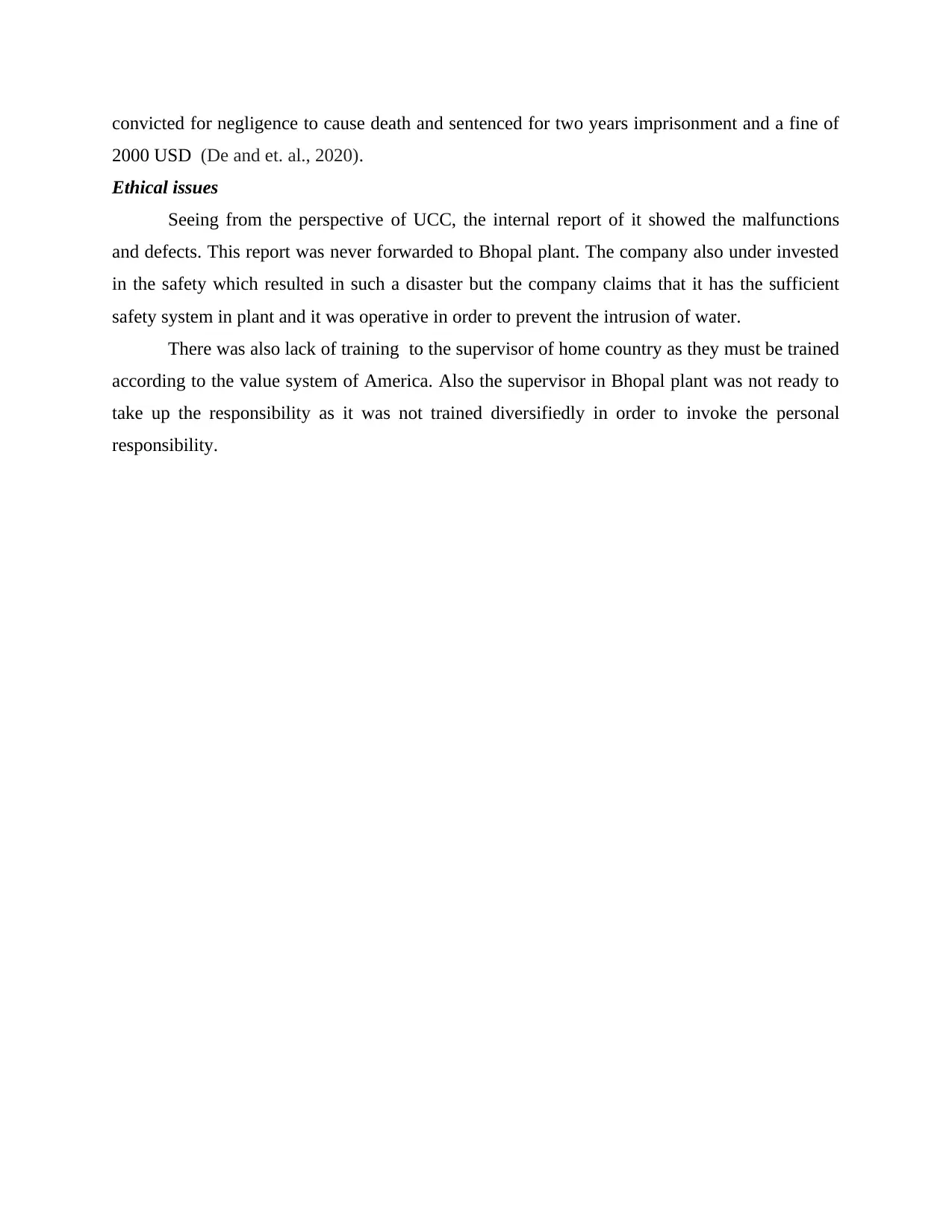
convicted for negligence to cause death and sentenced for two years imprisonment and a fine of
2000 USD (De and et. al., 2020).
Ethical issues
Seeing from the perspective of UCC, the internal report of it showed the malfunctions
and defects. This report was never forwarded to Bhopal plant. The company also under invested
in the safety which resulted in such a disaster but the company claims that it has the sufficient
safety system in plant and it was operative in order to prevent the intrusion of water.
There was also lack of training to the supervisor of home country as they must be trained
according to the value system of America. Also the supervisor in Bhopal plant was not ready to
take up the responsibility as it was not trained diversifiedly in order to invoke the personal
responsibility.
2000 USD (De and et. al., 2020).
Ethical issues
Seeing from the perspective of UCC, the internal report of it showed the malfunctions
and defects. This report was never forwarded to Bhopal plant. The company also under invested
in the safety which resulted in such a disaster but the company claims that it has the sufficient
safety system in plant and it was operative in order to prevent the intrusion of water.
There was also lack of training to the supervisor of home country as they must be trained
according to the value system of America. Also the supervisor in Bhopal plant was not ready to
take up the responsibility as it was not trained diversifiedly in order to invoke the personal
responsibility.
Paraphrase This Document
Need a fresh take? Get an instant paraphrase of this document with our AI Paraphraser
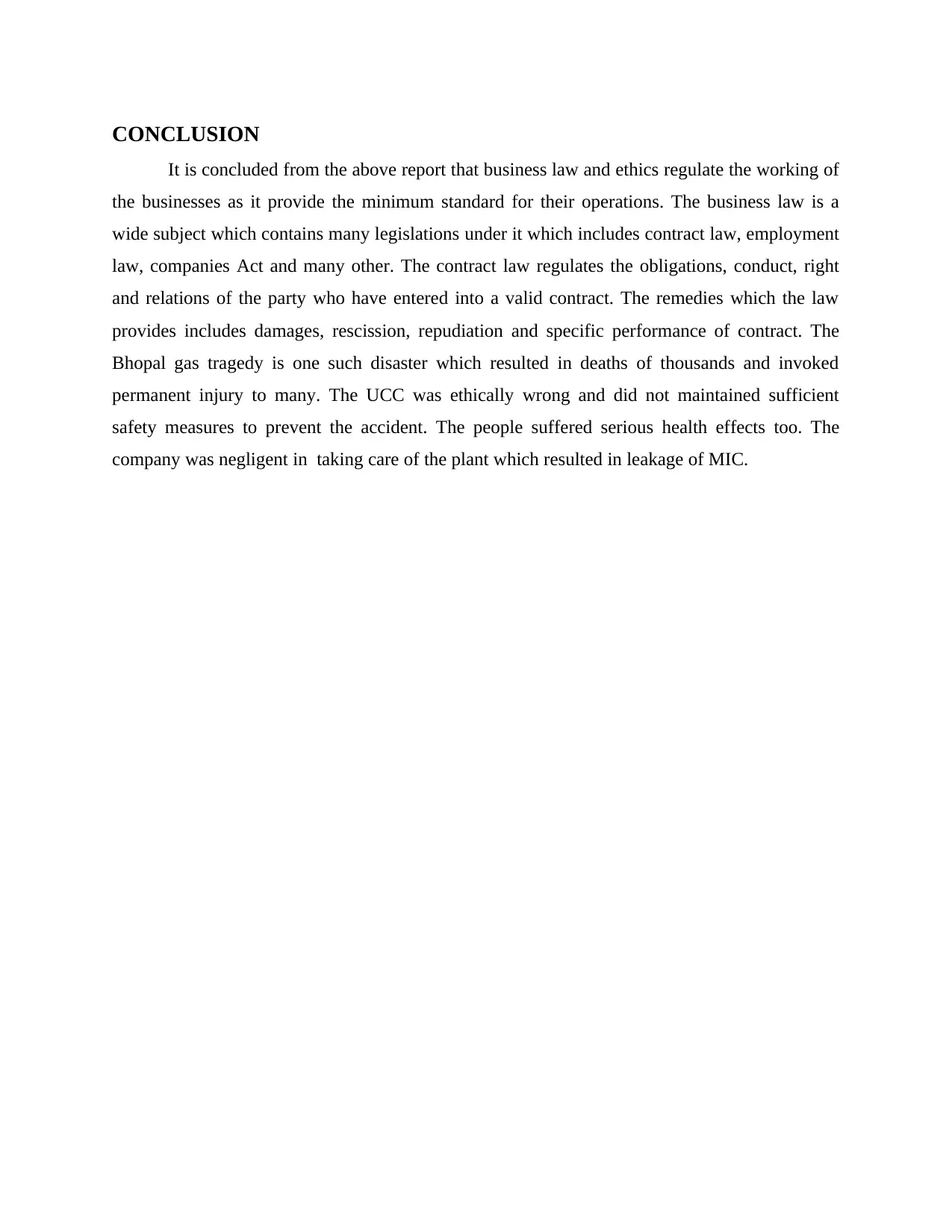
CONCLUSION
It is concluded from the above report that business law and ethics regulate the working of
the businesses as it provide the minimum standard for their operations. The business law is a
wide subject which contains many legislations under it which includes contract law, employment
law, companies Act and many other. The contract law regulates the obligations, conduct, right
and relations of the party who have entered into a valid contract. The remedies which the law
provides includes damages, rescission, repudiation and specific performance of contract. The
Bhopal gas tragedy is one such disaster which resulted in deaths of thousands and invoked
permanent injury to many. The UCC was ethically wrong and did not maintained sufficient
safety measures to prevent the accident. The people suffered serious health effects too. The
company was negligent in taking care of the plant which resulted in leakage of MIC.
It is concluded from the above report that business law and ethics regulate the working of
the businesses as it provide the minimum standard for their operations. The business law is a
wide subject which contains many legislations under it which includes contract law, employment
law, companies Act and many other. The contract law regulates the obligations, conduct, right
and relations of the party who have entered into a valid contract. The remedies which the law
provides includes damages, rescission, repudiation and specific performance of contract. The
Bhopal gas tragedy is one such disaster which resulted in deaths of thousands and invoked
permanent injury to many. The UCC was ethically wrong and did not maintained sufficient
safety measures to prevent the accident. The people suffered serious health effects too. The
company was negligent in taking care of the plant which resulted in leakage of MIC.
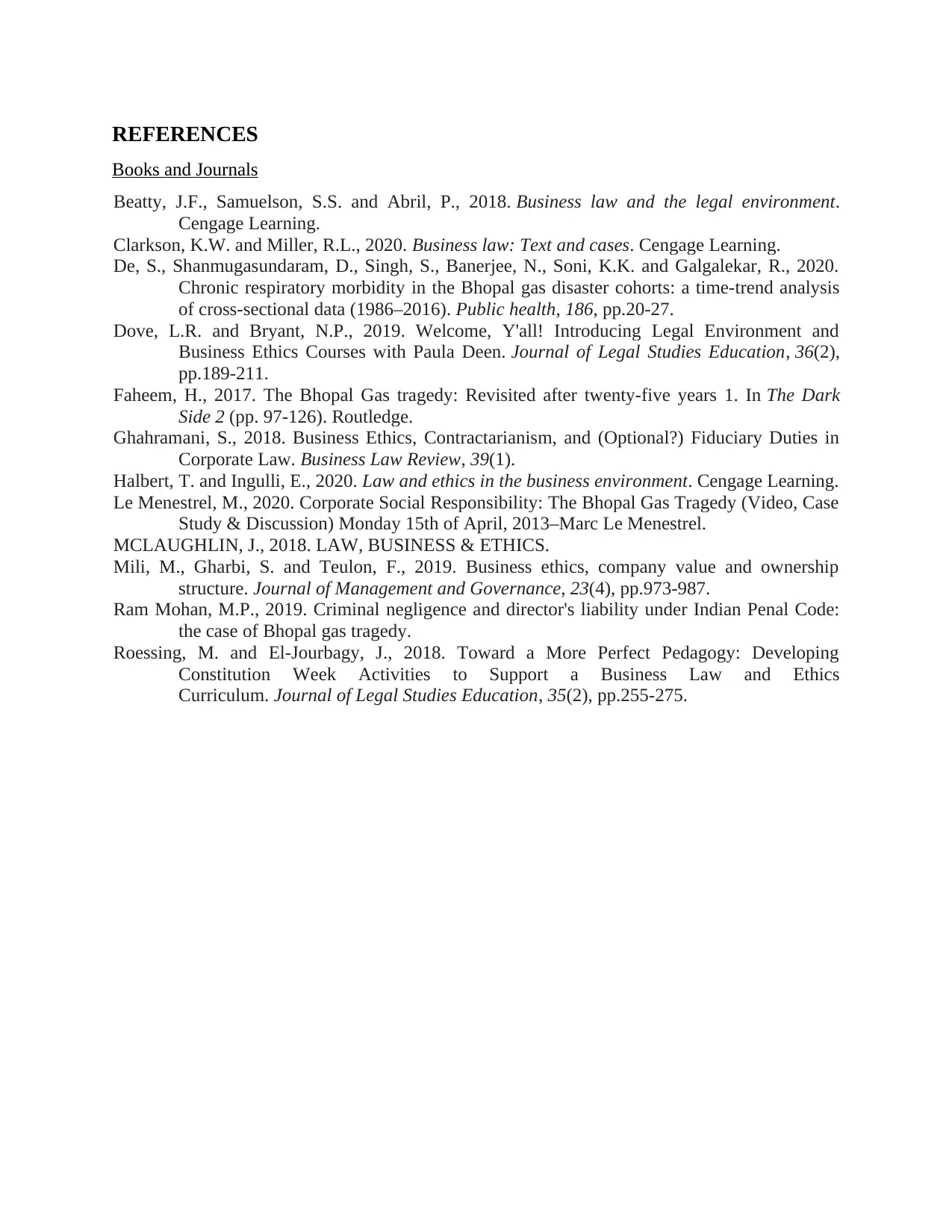
REFERENCES
Books and Journals
Beatty, J.F., Samuelson, S.S. and Abril, P., 2018. Business law and the legal environment.
Cengage Learning.
Clarkson, K.W. and Miller, R.L., 2020. Business law: Text and cases. Cengage Learning.
De, S., Shanmugasundaram, D., Singh, S., Banerjee, N., Soni, K.K. and Galgalekar, R., 2020.
Chronic respiratory morbidity in the Bhopal gas disaster cohorts: a time-trend analysis
of cross-sectional data (1986–2016). Public health, 186, pp.20-27.
Dove, L.R. and Bryant, N.P., 2019. Welcome, Y'all! Introducing Legal Environment and
Business Ethics Courses with Paula Deen. Journal of Legal Studies Education, 36(2),
pp.189-211.
Faheem, H., 2017. The Bhopal Gas tragedy: Revisited after twenty-five years 1. In The Dark
Side 2 (pp. 97-126). Routledge.
Ghahramani, S., 2018. Business Ethics, Contractarianism, and (Optional?) Fiduciary Duties in
Corporate Law. Business Law Review, 39(1).
Halbert, T. and Ingulli, E., 2020. Law and ethics in the business environment. Cengage Learning.
Le Menestrel, M., 2020. Corporate Social Responsibility: The Bhopal Gas Tragedy (Video, Case
Study & Discussion) Monday 15th of April, 2013–Marc Le Menestrel.
MCLAUGHLIN, J., 2018. LAW, BUSINESS & ETHICS.
Mili, M., Gharbi, S. and Teulon, F., 2019. Business ethics, company value and ownership
structure. Journal of Management and Governance, 23(4), pp.973-987.
Ram Mohan, M.P., 2019. Criminal negligence and director's liability under Indian Penal Code:
the case of Bhopal gas tragedy.
Roessing, M. and El-Jourbagy, J., 2018. Toward a More Perfect Pedagogy: Developing
Constitution Week Activities to Support a Business Law and Ethics
Curriculum. Journal of Legal Studies Education, 35(2), pp.255-275.
Books and Journals
Beatty, J.F., Samuelson, S.S. and Abril, P., 2018. Business law and the legal environment.
Cengage Learning.
Clarkson, K.W. and Miller, R.L., 2020. Business law: Text and cases. Cengage Learning.
De, S., Shanmugasundaram, D., Singh, S., Banerjee, N., Soni, K.K. and Galgalekar, R., 2020.
Chronic respiratory morbidity in the Bhopal gas disaster cohorts: a time-trend analysis
of cross-sectional data (1986–2016). Public health, 186, pp.20-27.
Dove, L.R. and Bryant, N.P., 2019. Welcome, Y'all! Introducing Legal Environment and
Business Ethics Courses with Paula Deen. Journal of Legal Studies Education, 36(2),
pp.189-211.
Faheem, H., 2017. The Bhopal Gas tragedy: Revisited after twenty-five years 1. In The Dark
Side 2 (pp. 97-126). Routledge.
Ghahramani, S., 2018. Business Ethics, Contractarianism, and (Optional?) Fiduciary Duties in
Corporate Law. Business Law Review, 39(1).
Halbert, T. and Ingulli, E., 2020. Law and ethics in the business environment. Cengage Learning.
Le Menestrel, M., 2020. Corporate Social Responsibility: The Bhopal Gas Tragedy (Video, Case
Study & Discussion) Monday 15th of April, 2013–Marc Le Menestrel.
MCLAUGHLIN, J., 2018. LAW, BUSINESS & ETHICS.
Mili, M., Gharbi, S. and Teulon, F., 2019. Business ethics, company value and ownership
structure. Journal of Management and Governance, 23(4), pp.973-987.
Ram Mohan, M.P., 2019. Criminal negligence and director's liability under Indian Penal Code:
the case of Bhopal gas tragedy.
Roessing, M. and El-Jourbagy, J., 2018. Toward a More Perfect Pedagogy: Developing
Constitution Week Activities to Support a Business Law and Ethics
Curriculum. Journal of Legal Studies Education, 35(2), pp.255-275.
⊘ This is a preview!⊘
Do you want full access?
Subscribe today to unlock all pages.

Trusted by 1+ million students worldwide
1 out of 12
Related Documents
Your All-in-One AI-Powered Toolkit for Academic Success.
+13062052269
info@desklib.com
Available 24*7 on WhatsApp / Email
![[object Object]](/_next/static/media/star-bottom.7253800d.svg)
Unlock your academic potential
Copyright © 2020–2025 A2Z Services. All Rights Reserved. Developed and managed by ZUCOL.





